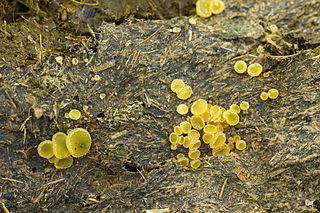
Thamnocalamus is a genus of clumping bamboo in the grass family. These species are found from the Himalayas as well as Madagascar and Southern Africa.

Hibiscus denudatus is a perennial shrub of the mallow family, Malvaceae. It is in the rosemallow genus, Hibiscus.

The Ascobolaceae are a family of fungi in the order Pezizales. A 2008 estimate places 6 genera and 129 species in the family.
Ammonia fungi are fungi that develop fruit bodies exclusively or relatively abundantly on soil that has had ammonia or other nitrogen-containing materials added. The nitrogen materials react as bases by themselves, or after decomposition. The addition of ammonia or urea causes numerous chemical and biological changes, for examples, the pH of soil litter is increased to 8–10; the high alkaline conditions interrupts the process of nutrient recycling. The mechanisms of colonization, establishment, and occurrence of fruiting bodies of ammonia fungi has been researched in the field and the laboratory.
Mirosternus denudatus is a species of beetle in the family Ptinidae.

Chicoreus denudatus, common name the branch-bearing murex, is a species of sea snail, a marine gastropod mollusk in the family Muricidae, the murex snails or rock snails.

Ascobolus is a genus of fungi in the Ascobolaceae family. The genus has a widespread distribution, and contains an estimated 61 species, most of which are coprophilous. The genus was circumscribed by Christian Hendrik Persoon in 1796.

Ascobolus carbonarius is a species of apothecial fungus belonging to the family Ascobolaceae.
Ascobolus stercorarius is a species of apothecial fungus belonging to the family Ascobolaceae.
Ascobolus brassicae is a species of apothecial fungus belonging to the family Ascobolaceae.
Holotrichius is a genus of assassin bugs.
In molecular biology, methylation induced premeiotically (MIP) is a process by which cytosines within repeated DNA sequences are de novo methylated prior to the sexual cycle. This process was first described in the ascomycete Ascobolus immersens. MIP is dependent upon the gene masc1 which encodes a cytosine methyltransferase-like protein. At least one major function of the process appears to be genome defense. Related functions have been found in other fungi, including Neurospora and Aspergillus species.
A. brassicae may refer to:
Chilocarpus is a genus of plant in the family Apocynaceae, first described as a genus in 1823. The genus is native to India, Southeast Asia, and New Guinea.
- Chilocarpus beccarianusPierre - Borneo
- Chilocarpus conspicuus(Steenis) Markgr. - Borneo
- Chilocarpus costatusMiq. - Borneo, Sumatra, W Malaysia, Thailand, Myanmar
- Chilocarpus decipiensHook.f. - Sumatra, W Malaysia
- Chilocarpus denudatusBlume - S India, Nicobar Islands, Indochina, Malaysia, Indonesia, New Guinea
- Chilocarpus hirtusD.J.Middleton - Borneo, Sumatra
- Chilocarpus obtusifoliusMerr. - Borneo, Sumatra, W Malaysia
- Chilocarpus pubescensD.J.Middleton - Borneo
- Chilocarpus rostratusMarkgr. - Borneo, Sumatra, W Malaysia, Thailand
- Chilocarpus sarawakensisD.J.Middleton - Sarawak
- Chilocarpus steenisianusMarkgr. - Borneo
- Chilocarpus suaveolensBlume - Borneo, Sumatra, Java
- Chilocarpus torulosus(Boerl.) Markgr. - Borneo
- Chilocarpus vernicosusBlume - Borneo, Sumatra, W Malaysia
Gastrolactarius is a genus of gasteroid fungi in the family Russulaceae. Although currently valid, this taxon is very likely a synonym of Lactarius.
Chilocarpus conspicuus is a plant in the genus Chilocarpus, in the family Apocynaceae. It is native to Borneo. The only information known about this species is from a collection from Mt Kinabalu, Brunei and two collections from Sarawak. There are several similar species that are alike in flower and without examining the distinctive fruit of this species, a specimen may be mistaken for Chilocarpus denudatus. It is an accepted species, first described by Steenis and originally published in Blumea 19: 162 1971.
Ascobolus immersus is a species of fungus belonging to the family Ascobolaceae.
Ascobolus brantophilus is a species of coprophilous fungus in the family Ascobolaceae. It grows on goose droppings.
Cyperus denudatus, commonly known as the winged sedge, is a species of sedge that is native to parts of Africa, Asia and eastern parts of Australia.
Leucocoprinus straminellus is a species of mushroom producing fungus in the family Agaricaceae. Like other Leucocoprinus species it may have originated in a tropical climate but now finds a home in plant pots, greenhouses and compost piles in many countries. Leucocoprinus straminellus is described as being similar to the more commonly known Leucocoprinus birnbaumii but it is smaller and a lighter shade of yellow with smaller spores that lack a germ pore. It is also described as being superficially similar to Leucocoprinus fragilissimus but slightly more robust with flesh that is less translucent.





